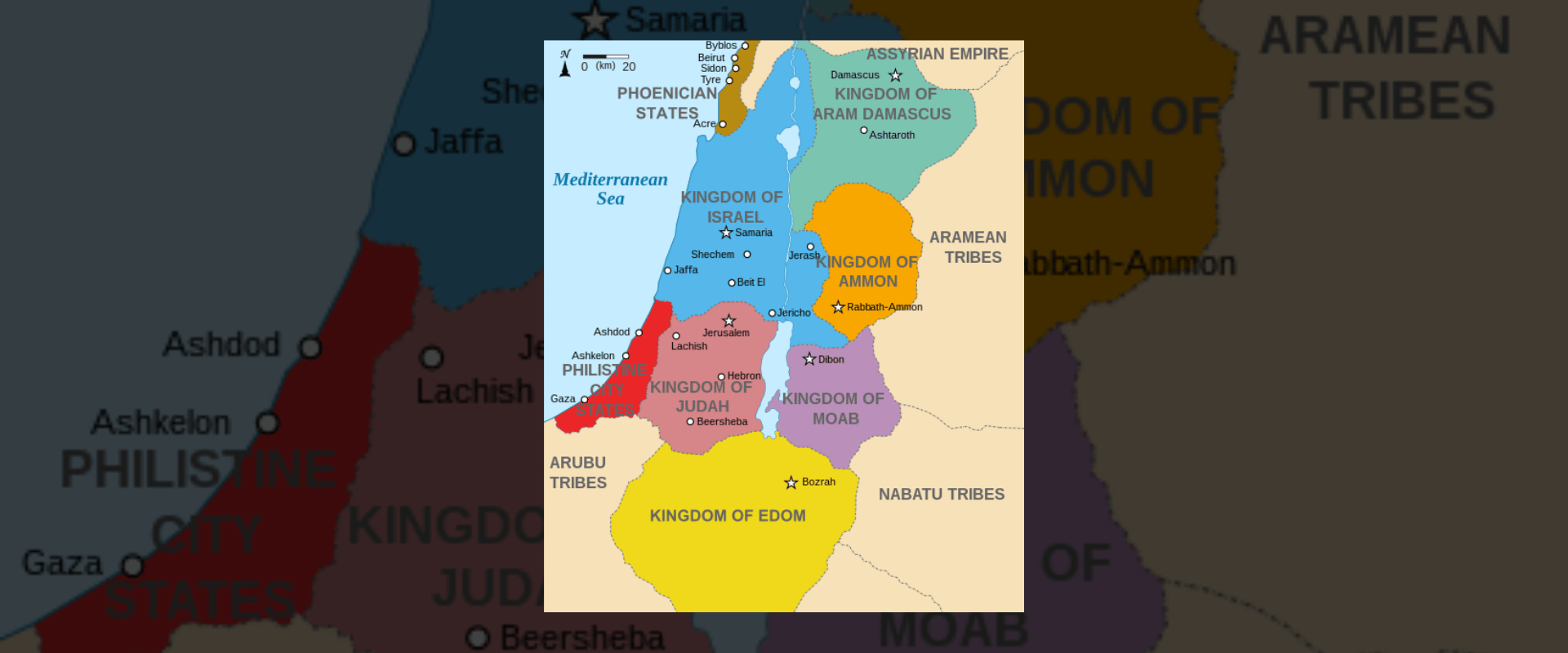Edomites: Biblical Legend or Real People? (PLUS Modern Day Edom)

Written by Marko Marina, Ph.D.
Author | Historian
Author | Historian | BE Contributor
Verified! See our guidelines
Verified! See our editorial guidelines
Date written: June 25th, 2024
Disclaimer: The views and opinions expressed in this article belong to the author and do not necessarily match my own. - Dr. Bart D. Ehrman
“So Esau (that is, Edom) settled in the hill country of Seir. This is the account of the family line of Esau the father of the Edomites in the hill country of Seir (Gen 36:8-9).” We find in the Old Testament texts references to different ancient people such as the Moabites, Ammonites, and Edomites.
For many readers, these names might evoke a sense of mystery. Were these groups real, historical entities, or are they the stuff of legend, like the famous Atlantida — woven into the fabric of ancient storytelling, but lacking historical authenticity?
The Edomites, it turns out, were, indeed, real people. Far from being mere figments of ancient imagination, they left behind a tangible legacy that scholars continue to uncover and study. They left us with enough information about their society, language, and culture to paint a vivid picture of their existence and interactions with other civilizations.
In the sections that follow, we will delve into the identity of the Edomites as depicted in the Bible, explore their linguistic heritage, trace their historical journey, and examine their lasting impact on the modern world.
By the end of this exploration, the Edomites will emerge not just as names in ancient texts, but as a real people with a rich and fascinating history.

Who Were Edomites in the Bible?
The term "Edomites" comes from the Hebrew word "Edom," which means “red”. This name is traditionally associated with Esau, the brother of Jacob, who was described as red and hairy at birth (Genesis 25:25). The descendants of Esau, often referred to as "Esau's descendants", settled in the region known as Edom. Where is Edom today? Modern-day Edom is located in southern Jordan and Israel.
The Bible frequently mentions the Edomites in various contexts. Moreover, they often interacted with the Israelites, sometimes as allies but more frequently as adversaries — as we’ll soon explore more.
Take, for instance, Numbers 20:14-21 which recounts a significant episode where the Israelites, led by Moses, sought passage through Edomite territory during their exodus from Egypt. The Edomites refused passage, which led to a prolonged animosity between the two groups: “But Edom answered: ‘You may not pass through here; if you try, we will march out and attack you with the sword’.”
The Edomite Kingdom
Historically, the Edomites are believed to have established a kingdom in the region known as Idumea, the Greek and Roman name for Edom. The name "Idumea" in the Bible refers to the same geographic area and its people.
For instance, Isaiah 34:5-6 prophesies against Edom, using “Idumea'' interchangeably: “My sword has drunk its fill in the heavens; see, it descends in judgment on Edom, the people I have totally destroyed. The sword of the Lord is bathed in blood, it’s covered with fat — the blood of lambs and goats, fat from the kidneys of rams. For the Lord has a sacrifice in Bozrah and a great slaughter in the land of Edom.”
The Edomite kingdom (Edom on a map) emerged as a significant political entity around the 13th century BCE, lasting until the 6th century BCE. Located south of the Dead Sea, Edom's rugged, mountainous region provided natural fortification and control over trade routes between Arabia and the Mediterranean.
This strategic position allowed the Edomites to thrive economically by taxing caravans and engaging in trade. Mentions of Bozrah in the Bible refer to the capital of Edom, with Petra (also known as Sela) becoming an important city in later periods.
In terms of social organization, the Edomite kingdom developed from a tribal organization to what Gunnar Lehmann called “the chiefdom”. As he explains: “In early states and chiefdoms, the extended families are assembled in a hierarchical system with mechanisms of “top-down” control. Early states and chiefdoms were usually ruled by monarchs. They exert and create hierarchical power structures through networks and communication with a low level of formal, non-bureaucratic institutions.”
It seems that already by the 9th century B.C.E., the Edomites formed a kingdom based on hierarchical power structures. Juan Manuel Tebes notes: “The archaeological remains excavated at Khirbet en-Nahas witness the development of a chiefdom polity in the lowlands of Edom in the 9th century B.C.E., with evidence of hierarchical relations of power, as attested by the erection of monumental buildings and defensive structures and the operation of highly specialized economic activities, including the mining and processing of the local copper ores.”
However, we shouldn’t overemphasize the central power of the monarch residing in Bozrah. As Tebes asserts: “Bozrah can be interpreted as a chiefdom whose sovereignty only encompassed the northern part of the Edomite highlands.”
The relationship between the Edomite kingdom and Israel was complex and multifaceted. Despite their common ancestry, as descendants of Isaac’s twin sons (Jacob and Esau), the Edomites and Israelites often found themselves at odds.
In his book Edom at the Edge of Empire, Bradley L. Crowell summarizes their relationship in the following way: “Edom was represented as a neighboring enemy of Judah that is the object of raids or invasions by Judahite kings, and at times, the partial occupation of the land. (Affiliate Disclaimer: We may earn commissions on products you purchase through this page at no additional cost to you. Thank you for supporting our site!) In many of the texts of the Deuteronomistic History (e.g. 1 Sam 14:47-48), Edom was used to illustrate the religious fidelity of the Judahite king in question: kings who were faithful to Yahweh expanded their territory to include Edom, kings who did not follow the proper precepts of Yahweh were subject to Edomite invasions.”
However, the Edomites regained their independence during the later years of Solomon's reign and continued to resist Israelite control. The hostilities persisted, with the Edomites frequently joining coalitions against Israel and Judah.
The Collapse of the Edomite Kingdom and the “Birth” of Idumeans
The decline of the Edomite kingdom began in the 6th century B.C.E. It was largely a consequence of the expansion of powerful neighboring empires. The Babylonian conquest of the region, followed by the rise of the Persian Empire, significantly weakened Edom’s political autonomy.
The Persians incorporated Edom into their vast empire. While they didn’t enforce their religion and allow a degree of local autonomy, Edom’s political independence was effectively over. In other words, Edomites continued to live in their ancestral lands, but their influence and control over the region diminished significantly.
Nevertheless, they, in part, maintained their social identity among the various groups who lived under the control and authority of the Persian Empire. As Amos Kloner and Ian Stern explain: “Coexistence among various ethnic groups under the Persians and later under the Ptolemies didn’t provoke or generate a competitive atmosphere that resulted in ethnocentrism.”
The evidence collected from the surviving ostraca dated to the 4th century B.C.E., for instance, suggests that Idumeans ceased to be a majority within the society, but they continued to maintain their own identity.
That being said, some things did change! By that time, the region of Edom was known as Idumea, which reflects the Hellenistic influence following Alexander the Great’s conquests. As was the case with the Jews, Edomites began to be assimilated into the broader Hellenistic world.
Most cultures find a nice balance between total assimilation and the overwhelming rejection of the dominant culture. In the case of Edomites, that didn’t happen. The final blow to Edomite autonomy came with the Jewish Hasmonean dynasty’s expansion in the 2nd century B.C.E.
According to Josephus (Ant. 13.256-257), John Hyrcanus I (a Hasmonian ruler) conquered Idumea around 110 B.C.E. and forcibly converted its inhabitants to Judaism. In other words, they were given the choice of either being circumcised and adopting the rest of “the laws of the Jews”, or of being expelled.
How much authenticity there is in Josephus’ account of the forcible conversion is disputed. However, most scholars agree that the Edomites were eventually integrated into Jewish society, meaning that the prevailing culture largely absorbed their unique identity.
In summary, the Edomites, members of the Esau family tree, were real historical people who played a significant role in the ancient Near East. Their interactions with Israel, their established kingdom of Idumea, and their mention in various biblical prophecies highlight their importance in biblical history.
As we continue to explore their language, culture, and religion, we uncover more about the intriguing history of the Edomites.
What Language Did Edomites Speak? Looking for Answers
Edomite is generally classified as a Northwest Semitic language, closely related to Hebrew, Moabite, and Phoenician. However, the precise classification of Edomite has been the subject of scholarly debate.
One of the key challenges is the need for more surviving texts. The extant inscriptions are few and fragmentary, making comprehensive linguistic analysis difficult or even impossible.
Michael Avi-Yonah, for instance, argued in his book The Holy Land from the Persian to the Arab Conquest, that the Edomite language was “of Arabian stock” thus suggesting a linguistic influence from the Arabian Peninsula.
This view posits that the Edomites, located at a crossroads of major trade routes, might have adopted linguistic elements from various cultures they interacted with, including Arabian traders and settlers.
However, the similarities between Edomite and other Northwest Semitic languages, especially Hebrew, have led to debates about whether Edomite was a distinct language or a dialect of Hebrew.
David Vanderhooft, for instance, notes: “None of the texts from the 7th or 6th centuries B.C.E. preserve linguistic information that suggests Edomite was an independent dialect. That is not to say that it absolutely was not. It’s merely to admit that based on the present evidence, there are no significant linguistic differences between texts that are demonstrably Edomite and texts written in the contemporary Hebrew of Cisjordan.”
Despite Vanderhooft's assertion, other scholars maintain that Edomite possessed unique linguistic characteristics that set it apart from Hebrew and other contemporaneous languages.
For example, Frank Moore Cross, in his work Early Hebrew Orthography: A Study of the Epigraphic Evidence, points to specific phonological and morphological features found in the limited corpus of Edomite inscriptions. Cross highlights variations in the use of personal pronouns and verb conjugations that suggest distinct linguistic patterns.
It should be noted that the evolution of the Edomite language was likely influenced by the region's political and cultural changes. As Edom came under the control of the Assyrians, Babylonians, and eventually the Persians, the language would have been exposed to external influences.
This linguistic blending might explain some of the ambiguities and similarities observed between Edomite and neighboring languages.

The Edomites Today? Understanding the Identity of a Group
Who are the Edomites today? As we noted in our earlier article on Cannanites, modern studies of group identities have shown that a simple equation of groups from ancient times with modern-day nations is highly problematic. Group identities are fluid and subject to changes over time, influenced by migration, cultural exchanges, and historical events.
As such, we can’t make a straightforward connection between a particular nation today and assert that they are the true descendants of the Edomites.
We mentioned that Edomites experienced a strong assimilation process (or processes!) as they went through the Babylonian conquest and later integrated into other (dominant) cultures such as Persia and Israel.
In that aspect, the purported conversion to Judaism at the end of the 2nd century B.C.E. marked a pivotal point in their cultural assimilation which eventually led to the loss of a distinct Edomite identity.
In light of these historical processes, tracing the modern descendants of the Edomites is a challenging task. While some groups in the region may carry genetic markers or cultural practices that hint at an Edomite ancestry, these links are often tenuous and speculative.
The concept of a linear, unbroken lineage from the ancient Edomites to a contemporary ethnic group oversimplifies the complex nature of human history and identity. Furthermore, political and social changes over millennia have continually reshaped the demographic and cultural landscape of the Middle East.
That being said, based on the assimilation that happened under the Hasmonean rule, we could (with great caution!) entertain the idea that among the modern Israelites, there are Esau descendants.
However, rather than seeking a direct lineage, it’s more fruitful to explore how the Edomites have influenced and been influenced by the people and cultures around them. Unfortunately, the scarcity of sources (both historical and archaeological) prevents us from achieving a greater degree of certainty.
Nevertheless, that shouldn’t stop us from trying to dig deeper to discover more about a nation that played a significant part in the early history of the Jewish people.
Conclusion
The Edomites, or "Esau's descendants," represent a fascinating chapter in the ancient history of the Near East. As a real historical people, they established the kingdom of Edom, which later became known as Idumea in the Bible.
Their interactions with the Israelites, including periods of conflict and cooperation, highlight the complex relationships that shaped the region's history. Furthermore, the Edomites' transition from a tribal society to a structured kingdom exemplifies the political and social developments characteristic of the ancient world.
Ultimately, the story of the Edomites illustrates the broader themes of cultural assimilation and identity transformation. As we continue to study their legacy, we gain a deeper understanding of how ancient peoples influenced and were influenced by their surroundings.
Intrigued by the mysteries of ancient peoples like the Edomites? Dive deeper into biblical history with Dr. Bart D. Ehrman’s online course, “Finding Moses - What Scholars Know About The Exodus and The Jewish Law”.
Explore the historical and legendary aspects of Moses, the evidence behind the Exodus, the origins of key biblical books, and the true meaning of the 10 Commandments. Enroll now to uncover the fascinating truths behind these age-old stories!

